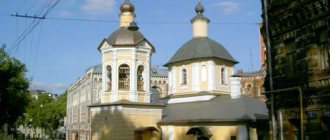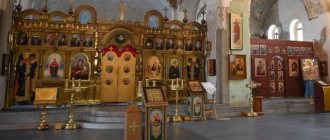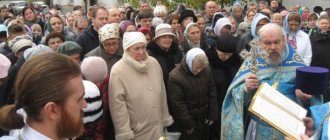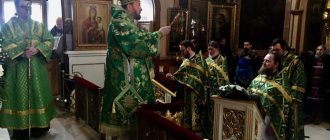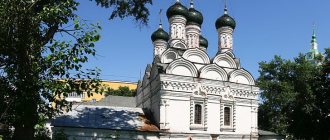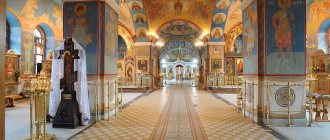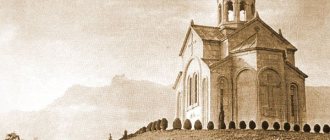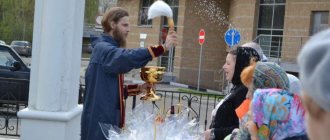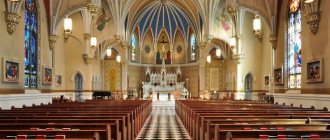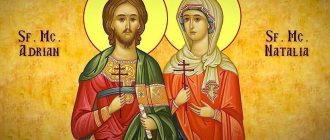| Moscow Church of the Martyrs Adrian and Natalia in Babushkino, 2006. Photo from the site sobory.ru |
Moscow Church in the name of the martyrs Adrian and Natalia in the Babushkino
Sergius deanery of the Moscow (city) diocese
- Thrones: mchch. Adrian and Natalia (main), icon of the Mother of God “Unexpected Joy” (southern), bl. Vasily Moskovsky (northern)
- Address: Russia, Moscow, Yaroslavskoye sh., 95
- Directions: from metro station "VDNKh" bus. 136, 172, 244, troll. 76, rest. "School"; platf. "Losinoostrovskaya" from Yaroslavsky station.
- Official site:
- On the map: Yandex.Map, Google map
The temple was built in 1914-1916 near the villages of Trade Servants, Dubnyaki and Krasnaya Sosna at the Losinoostrovskaya station of the Yaroslavl Railway.
The capital for construction (15 thousand rubles) was allocated by the hereditary honorary citizen of Moscow Alexander Ivanovich Ivanov, and the peasant Sergei Ivanovich Karpov donated his own land (1,736 square fathoms). The building project was developed by architect Vladimir Dmitrievich Glazov and engineer S.M. Fominsky; The temple was conceived in the neo-Russian style using Novgorod-Byzantine motifs. The construction work was led by the architect Sergei Mikhailovich Ilyinsky. The main altar was consecrated on April 2, 1916 by Archpriest Martyr John Vostorgov. The southern chapel, the icon of the Mother of God “Unexpected Joy”, was consecrated on August 21 of the same year by the Bishop of Mozhaisk Hieromartyr Dimitri (Dobroserdov). The northern aisle of Blessed Vasily of Moscow was consecrated on September 18 by the dean of the 6th district of the Moscow district, priest Vasily Gorodetsky.
During the years of anti-church persecution of the Soviet era, the temple was one of the few that was never closed. In 1931-1935, Hieromartyr Gregory Samarin served as a deacon here. At the end of the 1930s, the temple belonged to the Renovationists for some time, but was soon returned to the Orthodox believers.
Construction of the temple in Babushkino
The Temple of Adrian and Natalia arose at the Losinoostrovskaya station on the Yaroslavl railway. This place was very popular among Muscovites when the sale of individual land plots began in 1900, and they actively built up the station and the surrounding area with their dachas. The village grew very quickly and turned into a whole city; it had everything necessary for life. The most important thing was missing - their own temple, and without it they could neither baptize the baby nor see him off on his last journey.
The Moscow merchant of the 1st guild Ivanov donated a lot of money for the construction of the future temple - 15 thousand rubles, and a wealthy peasant Sergei Karpov offered his land plot of 800 square meters for the construction of the temple.
The petition submitted to the Moscow Spiritual Consistory was granted and on June 22, according to the old style, the solemn ceremony of laying the first stone of the Church of the Holy Martyrs Adrian and Natalia took place. The future church promised to be beautiful and quite original architecturally.
The church in Babushkino was built from 1914 to 1916 in the Russian-Byzantine style. Its estimated cost was 70,000 rubles. The main altar of the new church in honor of the Holy Martyrs Adrian and Natalia was consecrated on April 2, 1916, according to the old style. The solemn ceremony was performed by Archpriest John Vostorgov, rector of the famous Moscow Intercession Cathedral on the Moat, better known as St. Basil's Cathedral. The southern aisle was consecrated on August 21 of the same year in honor of the icon of the Mother of God “Unexpected Joy”. A month later, the northern aisle of the temple was consecrated in the name of Blessed Basil of Moscow, Christ for the sake of the holy fool.
However, 1917 was approaching and the Temple of Adrian and Natalia, like other churches, faced difficult times.
How to get there[edit]
Address:
129337, Moscow, Yaroslavskoe highway, building 61, building 1 (according to the old numbering - building 95) Nearest metro station: VDNKh station
Telephone:
(499) 183-27-92 (parish house), +7 (916) 422-16-38 (responsible for work with youth Konstantin Ozernov)
Email:
(responsible for work with youth Konstantin Ozernov), [email protected] (site editor)
Directions:
- from VDNH metro station: buses 136, 172, 244, trolleybus 76 to the Shkola stop;
- from Yaroslavsky station: by electric train to the Losinoostrovskaya platform.
History of the Temple of Adrian and Natalia in Babushkino
The dacha village of Losinoostrovsk near Moscow was transformed into a city in 1925, and 14 years later it was renamed Babushkin.
The doors of the church in Babushkino were never closed during Soviet times, so here one could see and hear the greatest figures of the Russian Orthodox Church, such as Patriarchs Tikhon and Pimen.
Beginning in 1936 and up to and including the Great Patriotic War, the Church of Adrian and Natalia was captured by representatives of the Renovationist Church. During the war, in the face of great danger, the country's attitude towards religion began to change and the state began to cooperate with the Russian Orthodox Church, and many believers were again able to hold services and perform religious rituals.
Already in 1960, the Church of the Holy Martyrs Adrian and Natalia finally became Moscow. Intensive construction of the Moscow Ring Road was underway, the capital was expanding, and the district, together with the church, became part of the huge city.
In the 1990s, the church in Babushkino found its new voice - a new stone belfry was installed opposite the entrance on the western side. At the beginning of the 21st century, a baptismal church was built in the name of the righteous Joachim and Anna with a large font. A chapel was also erected in the name of the prophet John the Baptist, whose icon parishioners worship in the main building of the temple. This chapel is blessed with water, and it is especially crowded here on Epiphany.
Current state[edit]
Interior of the temple
Description[edit]
The eclectic architecture of the building is designed in neo-Russian style using elements of Pskov architecture. The compact and proportionally balanced composition of the monument consists of the temple itself, which is a low domed rotunda on a quadrangle with a semicircular apse in plan, two symmetrical aisles on the sides and a vestibule with a porch on the western facade. The appeal to the motifs of Pskov architecture was manifested in the form of gabled completions of the side facades of the aisles and especially in the interpretation of the high second floor of the vestibule, imitating a Pskov-type belfry, completed with three domes. The interior of the church is designed as a single four-pillar space, illuminated by high arched windows. In the western part of the temple there are choirs. The temple has preserved most of the interior decoration features of the early twentieth century.
The church is located in an open space surrounded by modern multi-storey buildings and is clearly visible when driving along the Yaroslavskoye Highway, to which it faces with its eastern facade. The fence of the church site dates back to the first half of the 20th century, a small belfry to the west of the temple was erected in the 1990s[2]. In the first decade of the 21st century, the baptismal church of the righteous Joachim and Anna and a chapel for the blessing of water in honor of the Prophet John the Baptist were built on the territory of the temple. In 2014, a worship cross was erected in the courtyard in memory of the new martyrs Vladimir and Gregory.
- Baptismal Church of the Righteous Joachim and Anna in Babushkino
The baptismal temple of the holy righteous Joachim and Anna was built in 2000-2003 according to the design of architects Vladimir Vladimirovich Khodnev and Elena Georgievna Kostina. On June 21, 2003, the church was consecrated by Archbishop of Istra Arseny (Epifanov).
According to established tradition, services in the baptismal church are held twice a year: on the eve of the day of remembrance of Saints Joachim and Anna and on the holiday itself, September 9/22. On other days, the temple is used only for Baptism.
The temple is specially equipped for performing the Sacrament. In the western part there is a baptistery with a screen for changing clothes, and changing tables have been installed.
- Chapel of St. Sergius of Radonezh
The Chapel of St. Sergius of Radonezh was built in 1996-1998 in the traditions of Russian wooden architecture. In 1999, she was transferred to the care of the Church of the Martyrs Adrian and Natalia.
The chapel is open daily from 10-00 to 19-00. Every Wednesday at 14-00 there is a prayer service with an akathist.
On the great days of remembrance of the dead (on Trinity, Demetrius and Ecumenical parental Saturdays, as well as on the feast of Radonitsa), a great requiem service is held. On Monday, Tuesday, Wednesday and Thursday of the first week of Great Lent, the penitential canon of St. Andrew of Crete is read.
On Holy Saturday Easter cakes, Easter cakes and eggs are blessed.
On the days of memory of St. Sergius of Radonezh (July 5/18 and September 25/October 8), a solemn prayer service with an akathist and a religious procession around the chapel are held.
The chapel is located on Malygina Street next to the Svetlana sanatorium.
Directions - to the stop "Malygina Street" from the metro stations "Sviblovo" (buses 176, 185), "Babushkinskaya" (buses 605, 696, minibuses 46m, 482m), "Medvedkovo" (buses 774), station "Los" » Yaroslavl direction of the Moscow Railway (all listed routes).
- Chapel of the Prophet John the Baptist
The Chapel of the Prophet John the Baptist was built in 2005-2007. Vladimir Vladimirovich Khodnev and Elena Georgievna Kostina worked on its project - the same architects who had previously built the baptismal church.
On Epiphany Eve and the feast of Epiphany itself (January 18 and 19 according to the new style), Epiphany water is blessed and distributed here. And throughout the year, a parish Sunday school operates in the chapel and youth meetings are held.
Activities of the parish[edit]
- Sunday School
In 1992, a Sunday school for children was opened at the church, where they taught the basics of the Law of God and church singing. As of March 2015, the school has four groups (2.5-4 years, 5-6 years, 7-11 years and 12-16 years), with more than 60 students[5].
In preschool groups, classes are held according to the “Introduction to Tradition” program, approved by the Department of Religious Education and Catechesis of the Russian Orthodox Church. In the elementary level group, the main subject is the Law of God, in the basic level group - the Holy Scriptures of the Old and New Testaments, Fundamentals of Orthodox Doctrine, Liturgics, History of the Christian Church, History of the Russian Church, Christian Ethics.
Classes are taught by clergy and parishioners of the temple. The school runs from September to May on Wednesdays, Fridays, Saturdays and Sundays in the Chapel of St. John the Baptist.
- Public conversations
At the Church of the Martyrs Adrian and Natalia, mandatory conversations are held for those wishing to be baptized and married.
Interviews with everyone who is preparing for the Sacraments, as well as with the parents of baptized children and future godparents are conducted by the priest and the parish missionary-catechist on Saturdays at 16-00 and on Sundays at 15-30 (in May-August - at 14-30) at Sunday school premises (Chapel of John the Baptist).
- Work with youth
Every week, at the Church of the Martyrs Adrian and Natalia, meetings of young parishioners are held, in which the church cleric Archpriest Nikolai Krikota and the parish missionary-catechist Alexander Safonov participate. Issues related to the Orthodox faith, Russian history and culture, and the life of modern youth are discussed. Classes on Church history are being held.
Inside the Temple of Adrian and Natalia
The Church of the Holy Martyrs Adrian and Natalia in Babushkino was never closed for a long time and therefore retained most of its decoration in its original form. This is a single ensemble of simultaneously created interior details, chronologically corresponding to the very first years of the temple’s existence - the beginning of the 20th century.
In general, the interior of the Church of Adrian and Natalia is a single four-pillar space, which is illuminated by high windows in the shape of arches. A notable detail of the layout is the position of its side chapels, located on both sides of the main iconostasis almost in the same plane, in contrast to the traditional addition of them, for example, to the refectory.
The temple inside is quite spacious; According to the project, it is designed to accommodate 750 believers during services.
The walls of the temple and its dome area are completely covered with paintings. One of the most interesting motifs is the depiction of the four evangelists. In accordance with Orthodox tradition, they are written on each of the four sides of the cross-domed vault, the so-called sails.
During the years of godless power and persecution of the Church, icons were brought here from all over the area, saving them from destruction. As the clergy of the temple note, by the location of the icon cases one can determine stylistic differences, sometimes very large, which means that they formerly belonged to different temples.
On the right side of the temple, near the iconostasis, there is a unique reliquary. It includes 45 pieces of holy relics and 18 pieces of various shrines, which were collected by the honorary rector of the temple, Father Nikolai Dyatlov, for many years. In 1997, he donated the reliquary to his temple.
Everything here pleases both the eye and the heart. Inside the temple of Adrian and Natalia there is light from the Divine faces and warmth from the joy and hope that is given to everyone here.
